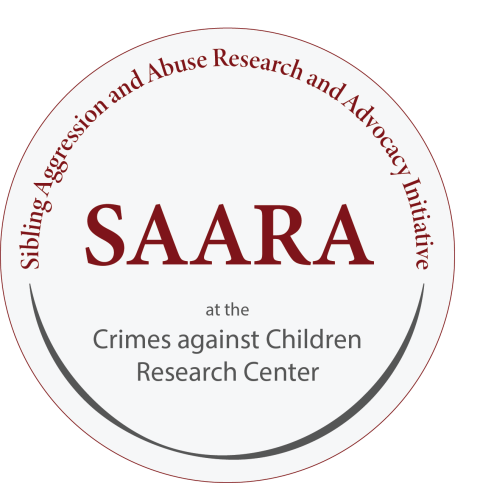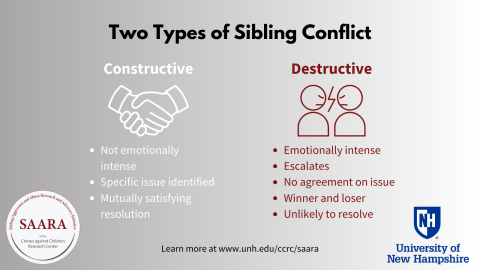Our aim at SAARA is to provide scientific information for researchers and practitioners to prevent and stop sibling aggression and abuse. Currently, there is a lack of awareness and response when sibling aggression occurs. Sibling aggression is commonly assumed to be "just rivalry" and harmless. Many professionals are not trained to recognize and intervene when sibling aggression and abuse occur in a family.

Mislabeling of sibling aggression as rivalry has led to confusion in terminology and a lack of guidance regarding its associated behaviors and impact on mental and physical health. However, sibling aggression causes suffering across the lifespan, and it typically co-occurs with other forms of family violence, like intimate partner violence and child maltreatment.
To address gaps in knowledge, recognition, and response to sibling aggression, we provide the following brief definitions, quick facts, printable bulletins, and infographics. For more in-depth information, find our research articles on our publications list.

There are a variety of terms used by researchers, clinicians, and organizations to refer to sibling aggression and abuse, including bullying, rivalry, violence, perpetration, and victimization. For the sake of clarity, we list definitions below of rivalry, aggression, abuse, and sexual abuse.
Rivalry is competition for or protests about parents’ or caregivers’ attention, favor, and resources (e.g., financial, time). As part of this competitive process, siblings may display jealousy and bicker.
Aggression means the intention to cause physical or psychological harm to a sibling and includes hitting, attacking, denigrating, humiliating, and destroying possessions and property.
Abuse usually means an ongoing pattern of aggression by a sibling with more power that causes evident harm or a strong likelihood of harm, but a serious one-time event can also be abuse.
Sexual abuse means sexual activities with a sibling that are unwanted or involve a considerable developmental or age difference.

A range of behaviors characterize sibling aggression and abuse experiences, including physical, psychological, sexual, and property aggression.
Aggression
Mild physical aggression: hit, beaten, or attacked without an object and no injury resulted.
Severe physical aggression: hit, beaten, or attacked with an object and/or injury resulted.
Property aggression: forcible taking, items stolen, vandalism, or purposeful destruction of possessions.
Psychological aggression: child felt bad or scared because he/she was called names, told mean things, or told the sibling did not want him/her around.
Abuse
Abuse: usually an ongoing pattern of aggression by a sibling with more power that causes evident harm or a strong likelihood of harm, but a serious one-time event can also be abuse.
Sexual abuse: sexual activities with a sibling that are unwanted or involve a considerable developmental or age difference.

A majority of children and youth in the United States grow up with a sibling.
A national survey shows about one-third of children aged 0-17 experienced sibling victimization in the past year.1
National surveys show that more children are victimized by a sibling than by a peer.2
Sibling aggression is the most common form of family violence.3
Sibling sexual abuse is infrequently reported and rarely studied and treated. It may be the most common form of intra-family sexual abuse.4
Sibling aggression peaks prior to adolescence, happening most often during early and middle childhood. A national study showed that 46% of six- to nine-years-old are victimized by a sibling.1
Sibling victimization is more common for brother-brother and closer-in-age sibling pairs and in white families and families with parents who have at least some college education.1, 5
Physical aggression is the most common form of sibling aggression.1
Severe sibling aggression which includes a weapon and/or injury is most common in adolescence.1
For 20% of children, victimization by a sibling is chronic.6
Sibling aggression is linked with family adversity,6 witnessing family violence,7, 8 inter-parental conflict,7, 8 inconsistent/harsh parenting5, 7, 8 or maltreatment,9 and certain child disabilities.10
Children and adolescents who report even one incident of sibling victimization over the past year report lower mental health than those who have not been victimized by a sibling.11, 12
Sibling aggression and victimization in childhood are linked with poorer mental health in adolescence.13
Sibling aggression and victimization experiences are linked to lower physical health.14, 15
Sibling victimization is predictive of being victimized by peers too. 12, 16, 17
Siblings can be perpetrators as well as victims of aggression with the same sibling.18
1 Tucker, C. J., Finkelhor, D., Shattuck, A., & Turner, H. (2013). Prevalence and correlates of sibling victimization types. Child Abuse & Neglect, 37(4), 213-223.
2 Finkelhor, D., Turner, H., Shattuck A., & Hamby, S. (2015). Prevalence of childhood exposure to violence, crime, and abuse: Results from the National Survey of Children’s Exposure to Violence. JAMA Pediatrics, 169(8), 746-754.
3 Straus, M. A., Gelles, R. J., & Steinmetz, S. K. (2006). Behind closed doors: Violence in the American family. New Brunswick, NJ: Transaction Publishing (Original work published 1980).
4 Finkelhor, D. (1980). Sex among siblings: A survey report on its prevalence, variety and effects. Archives of Sexual Behavior, 9(3), 171-194.
5 Toseeb, U., McChesney, G., Dantchev, S., & Wolke, D. (2020). Precursors of sibling bullying in middle childhood: Evidence from a UK-based longitudinal cohort study. Child Abuse & Neglect, 108.
6 Tucker, C. J., Finkelhor, D., & Turner, H. (2018). Family adversity’s role in the onset and termination of childhood sibling victimization. Psychology of Violence, 8(1), 10-18.
7 Tucker, C. J., Finkelhor, D., Turner, H., & Shattuck, A. (2015). Family dynamics and young children’s sibling victimization. Journal of Family Psychology, 28(5), 625-633.
8 Tucker, C. J., Finkelhor, D., & Turner, H. (2020). Family predictors of sibling versus peer victimization. Journal of Family Psychology, 34(2), 186-195.
9 Van Berkel, S. R., Tucker, C. J. & Finkelhor, D. (2018). The combination of sibling victimization and child maltreatment for mental health and delinquency. Child Maltreatment, 23(3), 244-253.
10 Tucker, C. J., Finkelhor, D., & Turner, H. (2017). Victimization by siblings in children with disability or weight problems. Journal of Developmental & Behavioral Pediatrics, 38(6), 378-384.
11 Tucker, C. J., Finkelhor, D., Turner, H., & Shattuck, A. (2013). Association of sibling aggression with child and adolescent mental health. Pediatrics, 132(1), 79-84.
12 Tucker, C. J., Finkelhor, D., Turner, H., & Shattuck, A. (2014). Sibling and peer victimization in childhood and adolescence. Child Abuse & Neglect, 38(10), 1599-1606.
13 Bowes, L., Wolke, D., Joinson, C., Lereya, S. T. & Lewis, G. (2014) Sibling bullying and risk of depression, anxiety, and self-harm: A prospective cohort study. Pediatrics, 134(4), e1032–e1039.
14 Tucker, C. J., & Kazura, K. (2013). Parental responses to sibling conflict of school-aged children. Journal of Child & Family Studies, 22(5), 737-745.
15 Tucker, C. J., Van Gundy, K., Sharp, E. H., & Rebellon, C. (2015). Brief report: Physical health of adolescent perpetrators of sibling aggression. Journal of Adolescence, 45(1), 171-173.
16 Tucker, C. J ., Finkelhor, D., & Turner, H. (2019). Patterns of sibling victimization as predictors of peer victimization in childhood and adolescence. Journal of Family Violence, 34(8), 745-755.
17 Tippett, N., & Wolke, D. (2015). Aggression between siblings: Associations with home environment and peer bullying. Aggressive Behavior, 41(1), 14-24.
18 Wolke, D., Tippett, N., & Dantchev, S. (2015). Bullying in the family: Sibling bullying. The Lancet Psychiatry, 2(10), 917-929.

Sibling and peer relationships figure prominently in children’s and adolescents’ lives. Although peers are often the focus of studies of aggression and bullying, national studies show that aggression and bullying are more common among siblings than they are peers.
The sibling relationship can serve as a training ground where children learn that bullying others is acceptable and a normal way to deal with others and get what they want.
Studies show that norms of acceptable behavior differ for sibling and peer relationships. Parents tend to view forms of aggression between siblings as not harmful and, in some cases, as good training for management of aggression in other relationships and social situations. Thus, social norms exist that support the expression of sibling aggression. As such, many parents do not try to stop it.
Sibling and peer aggression experiences appear to be linked. Children who bully their peers report the highest frequency of sibling bullying. Studies also show that victimization by a sibling is a risk factor for experiencing peer victimization, with about 15% of children and adolescents experiencing both sibling and peer victimization. Further, those children who are chronically victimized by a sibling are at the most risk for peer victimization.
Children and adolescents victimized by both siblings and peers, rather than by just siblings or peers, report the greatest mental distress (i.e., depression, anxiety, and anger).
(#1) Disentangling Sibling Rivalry from Aggression and Abuse
This bulletin distinguishes rivalry, aggression, and abuse in sibling relationships.
(#2) Recommendations for Parents on Managing Sibling Conflict and Aggression
This bulletin provides guidance to parents on how to manage sibling conflict, as well as what to do when sibling conflict goes too far.
(#3) Sibling Aggression and Abuse: Recommendations and Resources for Parents and Professionals
The goal of this bulletin is to provide guidance for parents and professionals on preventing and responding to sibling aggression and abuse.
(#4) What is the Line: When Does Sibling Conflict, Teasing, and Roughhousing Become Something More Serious?
This bulletin provides guidance on identifying when sibling behavior has crossed the line.
(#5) Demographic Variation in Sibling Aggression and Abuse
This bulletin reviews variation in sibling aggression rates and perceptions by race and ethnicity, gender, social class, ability, and sexual identity.
(#6) Do State Child Abuse and Neglect Policies Address Sibling Abuse?
This bulletin explores how U.S. state-level child abuse and neglect laws and policies can be applied to sibling abuse cases.
(#7) Recognizing and Responding to Sibling Sexual Abuse
The goal of this bulletin is to define sibling sexual abuse and provide guidance for parents and professionals on how to respond.
(#8) Sibling Aggression and Abuse are ACEs
This bulletin argues that sibling aggression and abuse meet the criteria for adverse childhood experiences and advocates for screening and training.
(#9) Addressing Sibling Aggression is Key to Reducing Peer Bullying
This bulletin reviews research on the link between sibling aggression and peer bullying and provides guidance for educators.
“Sibling Violence” by John Caffaro, PhD for the American Association for Marriage and Family Therapy
“Improving Sibling Relationships” by Kirsten Weir in the APA Monitor on Psychology
"Seven Steps to Teaching Children Body Autonomy" by Shalon Nienow, MD





